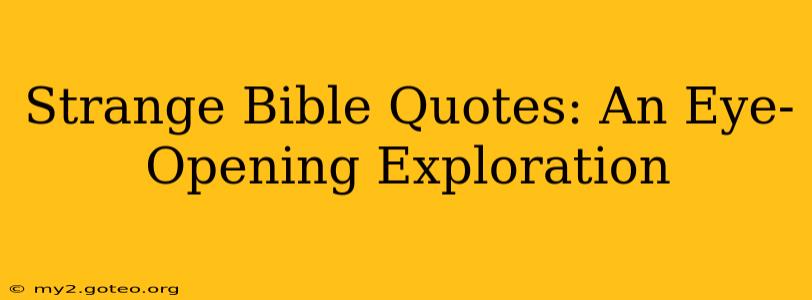The Bible, a cornerstone of Western civilization, is a collection of texts rich in wisdom, parables, and prophecies. However, nestled within its pages are verses that, at first glance, appear perplexing, contradictory, or even strange. This exploration delves into some of these seemingly unusual quotes, offering context and interpretation to shed light on their often-misunderstood meanings. We'll uncover the historical and cultural nuances that shape these passages, demonstrating how seemingly strange verses can be profoundly insightful when examined within their proper context.
What are some of the most unusual Bible verses?
This is a subjective question, as "unusual" depends on individual interpretation and familiarity with biblical texts. However, several verses consistently spark curiosity and debate due to their seemingly harsh or bizarre commands, or their metaphorical language that is difficult to decipher in modern times. We will explore some of these passages below.
Why are some Bible quotes so strange?
The strangeness of certain biblical quotes often stems from several factors:
-
Cultural Differences: The Bible was written over centuries across diverse cultures. Practices and beliefs considered normal then might seem strange or even cruel to us today. Understanding the historical context is crucial to avoid misinterpretation.
-
Figurative Language: Much of the Bible employs metaphors, similes, and hyperbole. Literal interpretations can lead to misconstruing the intended meaning. The Bible often utilizes poetic language to convey deeper spiritual truths.
-
Translation Challenges: The Bible has been translated countless times, and nuances can be lost or altered in the process. Different translations may present seemingly conflicting interpretations of the same verse.
-
Ambiguity and Mystery: Some passages intentionally remain open to interpretation, stimulating reflection and theological debate. This ambiguity can contribute to a sense of strangeness or even mystery.
Does the Bible contradict itself?
The apparent contradictions within the Bible are a frequent source of criticism. However, these contradictions often vanish when considering:
-
Different Literary Genres: The Bible isn't a single, unified book; it's a collection of different literary genres—poetry, law, history, prophecy, and parables. Each genre has its own style and purpose, and interpreting them all as literal historical accounts leads to inconsistencies.
-
Multiple Perspectives: The Bible contains accounts from multiple authors, perspectives, and time periods. Slight variations in narratives don't necessarily indicate contradiction but rather reflect different viewpoints on the same event.
-
Developing Understanding: Our understanding of the Bible evolves over time as we gain new insights into historical context and cultural nuances. What might seem contradictory today might become clearer with further study.
What are some examples of difficult or strange passages in the Bible?
Let's examine a few examples often cited as unusual or difficult:
"An eye for an eye, a tooth for a tooth" (Exodus 21:24)
This passage, often interpreted as a call for revenge, is best understood within its ancient Near Eastern context. It wasn't meant to endorse endless retaliation but rather to limit revenge. It set a precedent for proportionate justice, preventing excessive punishment.
"Love your enemies" (Matthew 5:44)
This seemingly impossible command challenges our natural inclinations. It doesn't advocate passive acceptance of evil but rather a radical shift in perspective, urging compassion and forgiveness even towards those who harm us. This is a call to spiritual growth and transcending base instincts.
The Book of Revelation
Often seen as filled with strange imagery and cryptic prophecies, Revelation is best understood as apocalyptic literature, using symbolic language to depict spiritual struggles and the ultimate triumph of good over evil. A literal interpretation risks missing the powerful message of hope and faith it offers.
Conclusion: Understanding the Strange in the Sacred
The seemingly strange quotes within the Bible are not necessarily errors or contradictions but often a result of cultural differences, figurative language, translation challenges, and intentional ambiguity. By considering the historical and literary context, engaging in careful interpretation, and acknowledging the complexities of faith, we can move beyond a superficial understanding and discover the deeper meaning within these often-misunderstood passages. It is through this deeper understanding that the strange becomes insightful, the perplexing becomes profound, and the seemingly contradictory becomes a rich tapestry woven with the threads of faith, history, and spiritual truth.

